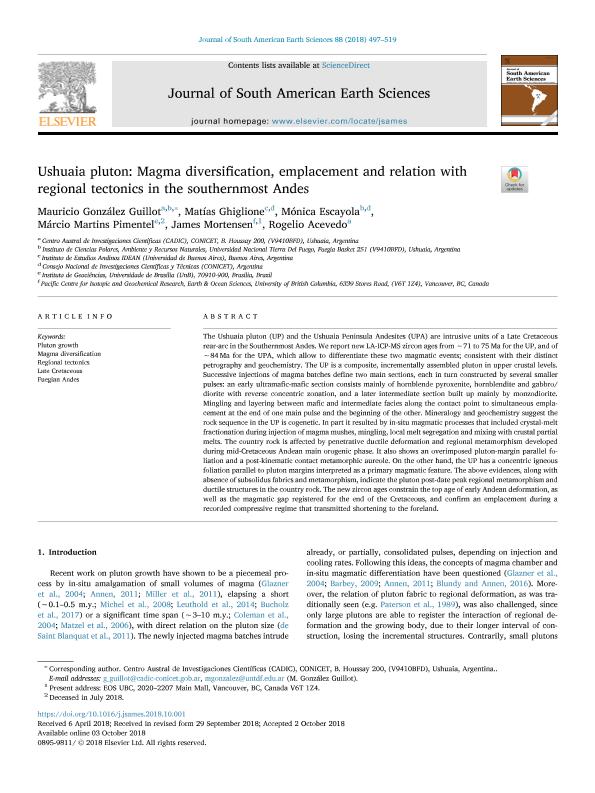Mostrar el registro sencillo del ítem
dc.contributor.author
Gonzalez Guillot, Mauricio Alberto

dc.contributor.author
Ghiglione, Matias

dc.contributor.author
Escayola, Monica Patricia

dc.contributor.author
Martins Pimentel, Márcio

dc.contributor.author
Mortensen, James
dc.contributor.author
Acevedo, Rogelio Daniel

dc.date.available
2019-10-18T19:15:58Z
dc.date.issued
2018-12
dc.identifier.citation
Gonzalez Guillot, Mauricio Alberto; Ghiglione, Matias; Escayola, Monica Patricia; Martins Pimentel, Márcio; Mortensen, James; et al.; Ushuaia pluton: Magma diversification, emplacement and relation with regional tectonics in the southernmost Andes; Pergamon-Elsevier Science Ltd; Journal of South American Earth Sciences; 88; 12-2018; 497-519
dc.identifier.issn
0895-9811
dc.identifier.uri
http://hdl.handle.net/11336/86458
dc.description.abstract
The Ushuaia pluton (UP) and the Ushuaia Peninsula Andesites (UPA) are intrusive units of a Late Cretaceous rear-arc in the Southernmost Andes. We report new LA-ICP-MS zircon ages from ∼71 to 75 Ma for the UP, and of ∼84 Ma for the UPA, which allow to differentiate these two magmatic events; consistent with their distinct petrography and geochemistry. The UP is a composite, incrementally assembled pluton in upper crustal levels. Successive injections of magma batches define two main sections, each in turn constructed by several smaller pulses: an early ultramafic-mafic section consists mainly of hornblende pyroxenite, hornblendite and gabbro/diorite with reverse concentric zonation, and a later intermediate section built up mainly by monzodiorite. Mingling and layering between mafic and intermediate facies along the contact point to simultaneous emplacement at the end of one main pulse and the beginning of the other. Mineralogy and geochemistry suggest the rock sequence in the UP is cogenetic. In part it resulted by in-situ magmatic processes that included crystal-melt fractionation during injection of magma mushes, mingling, local melt segregation and mixing with crustal partial melts. The country rock is affected by penetrative ductile deformation and regional metamorphism developed during mid-Cretaceous Andean main orogenic phase. It also shows an overimposed pluton-margin parallel foliation and a post-kinematic contact metamorphic aureole. On the other hand, the UP has a concentric igneous foliation parallel to pluton margins interpreted as a primary magmatic feature. The above evidences, along with absence of subsolidus fabrics and metamorphism, indicate the pluton post-date peak regional metamorphism and ductile structures in the country rock. The new zircon ages constrain the top age of early Andean deformation, as well as the magmatic gap registered for the end of the Cretaceous, and confirm an emplacement during a recorded compressive regime that transmitted shortening to the foreland.
dc.format
application/pdf
dc.language.iso
eng
dc.publisher
Pergamon-Elsevier Science Ltd

dc.rights
info:eu-repo/semantics/openAccess
dc.rights.uri
https://creativecommons.org/licenses/by-nc-sa/2.5/ar/
dc.subject
FUEGIAN ANDES
dc.subject
LATE CRETACEOUS
dc.subject
MAGMA DIVERSIFICATION
dc.subject
PLUTON GROWTH
dc.subject
REGIONAL TECTONICS
dc.subject.classification
Geología

dc.subject.classification
Ciencias de la Tierra y relacionadas con el Medio Ambiente

dc.subject.classification
CIENCIAS NATURALES Y EXACTAS

dc.title
Ushuaia pluton: Magma diversification, emplacement and relation with regional tectonics in the southernmost Andes
dc.type
info:eu-repo/semantics/article
dc.type
info:ar-repo/semantics/artículo
dc.type
info:eu-repo/semantics/publishedVersion
dc.date.updated
2019-10-10T13:45:58Z
dc.journal.volume
88
dc.journal.pagination
497-519
dc.journal.pais
Estados Unidos

dc.description.fil
Fil: Gonzalez Guillot, Mauricio Alberto. Consejo Nacional de Investigaciones Científicas y Técnicas. Centro Austral de Investigaciones Científicas; Argentina. Universidad Nacional de Tierra del Fuego. Instituto de Ciencias Polares, Recursos Naturales y Ambiente; Argentina
dc.description.fil
Fil: Ghiglione, Matias. Consejo Nacional de Investigaciones Científicas y Técnicas. Oficina de Coordinación Administrativa Ciudad Universitaria. Instituto de Estudios Andinos "Don Pablo Groeber". Universidad de Buenos Aires. Facultad de Ciencias Exactas y Naturales. Instituto de Estudios Andinos "Don Pablo Groeber"; Argentina
dc.description.fil
Fil: Escayola, Monica Patricia. Consejo Nacional de Investigaciones Científicas y Técnicas. Centro Austral de Investigaciones Científicas; Argentina. Universidad Nacional de Tierra del Fuego. Instituto de Ciencias Polares, Recursos Naturales y Ambiente; Argentina
dc.description.fil
Fil: Martins Pimentel, Márcio. Universidade do Brasília; Brasil
dc.description.fil
Fil: Mortensen, James. University of British Columbia; Canadá
dc.description.fil
Fil: Acevedo, Rogelio Daniel. Consejo Nacional de Investigaciones Científicas y Técnicas. Centro Austral de Investigaciones Científicas; Argentina
dc.journal.title
Journal of South American Earth Sciences

dc.relation.alternativeid
info:eu-repo/semantics/altIdentifier/doi/http://dx.doi.org/10.1016/j.jsames.2018.10.001
dc.relation.alternativeid
info:eu-repo/semantics/altIdentifier/url/https://www.sciencedirect.com/science/article/pii/S089598111830155X
Archivos asociados
